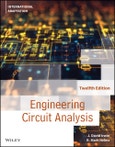Circuit analysis is the fundamental gateway course for computer and electrical engineering majors. Irwin and Nelms’ Engineering Circuit Analysis has long been regarded as the most dependable textbook on the subject. Focusing on the most complete set of pedagogical tools available and student-centered learning design, this book helps students complete the connection between theory and practice and build their problem-solving skills. Key concepts are explained multiple times in varying formats to support diverse learning styles, followed by detailed examples, including application and design examples. These are then followed by Learning Assessments, which allow students to work similar problems and check their results against the answers provided. At the end of each chapter, the book includes a robust set of conceptual and computational problems at a wide range of difficulty levels.
This International Adaptation enhances the coverage of network theorems by adding new theorems such as reciprocity, compensation, and Millman’s, and strengthens the topic of filter networks by including cascaded and Butterworth filters. This edition also includes inverse hybrid and inverse transmission parameters to describe two-port networks and a dedicated chapter on diodes
Table of Contents
1 Basic Concepts
1.1 System of Units
1.2 Basic Quantities
1.3 Circuit Elements
Summary
Problems
2 Resistive Circuits
2.1 Ohm’s Law
2.2 Kirchhoff’s Laws
2.3 Single-Loop Circuits
2.4 Single-Node-Pair Circuits
2.5 Series and Parallel Resistor Combinations
2.6 Circuits with Series-Parallel Combinations of Resistors
2.7 Wye ⇌ Delta Transformations
2.8 Circuits with Dependent Sources
2.9 Resistor Technologies for Electronic Manufacturing
2.10 Application Examples
2.11 Design Examples
Summary
Problems
3Network Theorems
3.1 Nodal Analysis
3.2 Loop Analysis
3.3 Equivalence and Linearity
3.4 Superposition
3.5 Thevenin’s and Norton’s Theorems
3.6 Maximum Power Transfer
3.7 Reciprocity Theorem
3.8 Compensation Theorem
3.9 Millman’s Theorem
3.10 Application Examples
3.11 Design Examples
Summary
Problems
4 Operational Amplifiers
4.1 Introduction
4.2 Op-Amp Models
4.3 Fundamental Op-Amp Circuits
4.4 Comparators
4.5 Application Examples
4.6 Design Examples
Summary
Problems
5 Capacitance and Inductance
5.1 Capacitors
5.2 Inductors
5.3 Capacitor and Inductor Combinations
5.4 RC Operational Amplifier Circuits
5.5 Application Examples
5.6 Design Examples
Summary
Problems
6 First- and Second-Order Transient Circuits
6.1 Introduction
6.2 First-Order Circuits
6.3 Second-Order Circuits
6.4 Application Examples
6.5 Design Examples
Summary
Problems
7 Sinusoidal Steady-State Analysis
7.1 Sinusoids
7.2 Sinusoidal and Complex Forcing Functions
7.3 Phasors
7.4 Phasor Relationships for Circuit Elements
7.5 Impedance and Admittance
7.6 Phasor Diagrams
7.7 Basic Analysis Using Kirchhoff’s Laws
7.8 Analysis Techniques
7.9 Application Examples
7.10 Design Examples
Summary
Problems
8 Steady-State Power Analysis
8.1 Instantaneous Power
8.2 Average Power
8.3 Maximum Average Power Transfer
8.4 Effective or RMS Values
8.5 The Power Factor
8.6 Complex Power
8.7 Power Factor Correction
8.8 Single-Phase Three-Wire Circuits
8.9 Safety Considerations
8.10 Application Examples
8.11 Design Examples
Summary
Problems
9 Magnetically Coupled Networks
9.1 Mutual Inductance
9.2 Energy Analysis
9.3 The Ideal Transformer
9.4 Safety Considerations
9.5 Application Examples
9.6 Design Examples
Summary
Problems
10 Three-Phase Circuits
10.1 Three-Phase Circuits
10.2 Three-Phase Connections
10.3 Source/Load Connections
10.4 Power Relationships
10.5 Unbalanced Load Connections
10.6 Power Factor Correction
10.7Application Examples
10.8 Design Examples
Summary
Problems
11 Variable-Frequency Network Performance
11.1 Variable Frequency-Response Analysis
11.2 Sinusoidal Frequency Analysis
11.3 Resonant Circuits
11.4 Scaling
11.5 Filter Networks
11.6 Application Examples
11.7 Design Examples
Summary
Problems
12 The Laplace Transform
12.1 Definition
12.2 Step and Impulse Functions
12.3 Transform Pairs
12.4 Properties of the Laplace Transform
12.5 Performing the Inverse Transform
12.6 Convolution Integral
12.7 Initial-Value and Final-Value Theorems
12.8 Solving Differential Equations Using Laplace Transforms
Summary
Problems
13 Application of the Laplace Transform to Circuit Analysis
13.1 Laplace Circuit Solutions
13.2 Circuit Element Models
13.3 Analysis Techniques
13.4 Transfer Function
13.5 Pole-Zero Plot/Bode Plot Connection
13.6 Steady-State Response
Summary
Problems
14 Fourier Analysis Techniques
14.1 Fourier Series
14.2 Fourier Transform
14.3 Application Example
14.4 Design Examples
Summary
Problems
15 Two-Port Networks
15.1 Admittance Parameters
15.2 Impedance Parameters
15.3 Hybrid Parameters
15.4 Transmission Parameters
15.5 Inverse Hybrid Parameters
15.6 Inverse Transmission Parameters
15.7 Parameter Conversions
15.8 Interconnection of Two-Port Networks
Summary
Problems
16 Diodes
16.1 Introduction
16.2 Modeling Techniques
16.3 Analysis Using the Diode Equation
16.4 Diode Rectifiers
16.5 Zener Diodes
Summary
Problems
APPENDIX A Complex Numbers
APPENDIX B Fundamental of Engineering (FE) Exam Problems (online supplement)
Index








